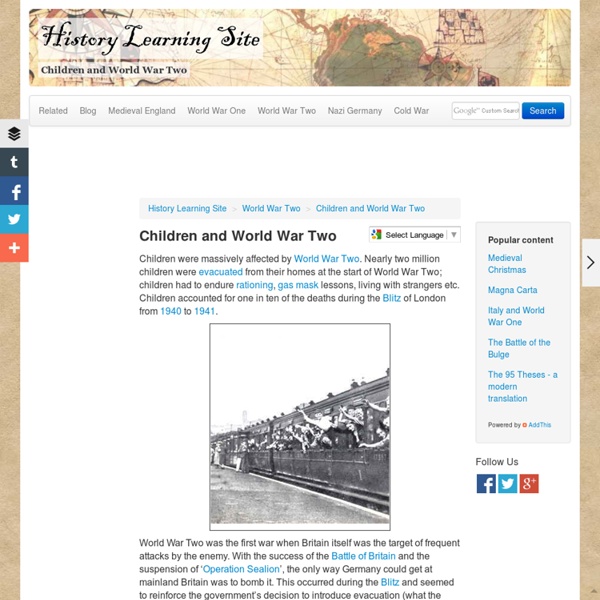Zoom
Trash
Related:



Primary History - World War 2 - Growing up in wartime Children of the Blitz Sounds: These sound effects have either been created by my self or gathered from sources on the internet. Feel free to utilise them in your show or to use them as the basis for the creation of your own effects. All of the sounds are in mp3 format. To hear the sounds just left click on them. If you feel that any of these sounds are in breach of copyright, then please contact me and I will remove them from the site. Speeches: Chamberlain's declaration of war Churchill - "We will fight them on the beaches..." Churchill - "...their Finest Hour" speech at the end of The Battle of Britain Songs: White Cliff of Dover - Vera Lyn There'll Always be an England - Vera Lyn In the Mood - Glenn Miller On a Wing and a Prayer - Anne Shelton Moonlight Serenade - Glenn Miller I Did What I Could with my Gas Mask - George Formby Get in your Shelter - Arthur Askey The London that I Love Could You Please Oblige Us with a Bren Gun - Noel Coward If a Grey-haired Lady Says "How's Your Father" - Flanagan and Allen Sound Effects:
Primary History - World War 2 - Children at war Primary History - World War 2 Evacuations of civilians in Britain during World War II The evacuation of civilians in Britain during the Second World War was designed to save civilians in Britain, particularly children, from the risks associated with aerial bombing of cities by moving them to areas thought to be less at risk. Operation Pied Piper, which began on 1 September 1939, officially relocated more than 3.5 million people. Further waves of official evacuation and re-evacuation occurred on the south and east coasts in June 1940, when a seaborne invasion was expected, and from affected cities after the Blitz began in September 1940. There were also official evacuations from the UK to other parts of the British Empire, and many non-official evacuations within and from the UK. Evacuation Scheme[edit] Child evacuees from Bristol arriving at Brent in Devon in 1940 In summer 1939, the government began to publicise its plan through the local authorities. Evacuation[edit] Evacuees from Bristol boarding a bus at Kingsbridge in Devon en route to their billets in 1940
World War II History: The Holocaust for Kids History >> World War 2 for Kids What was it? The Holocaust is one of the most terrible events in human history. It occurred during World War II when Hitler was leader of Germany. Six million Jewish people were murdered by the Nazis. This included as many as 1 million Jewish children. Millions of other people that Hitler didn't like were killed as well. A Jewish boy and mother being arrested Why did Hitler and the Nazis do it? Hitler hated Jewish people and blamed them for Germany losing World War I. Hitler wrote in his book Mein Kampf that when he became ruler he would rid Germany of all the Jews. Ghettos During World War II when the Nazis would take over a city in Europe they would force all of the Jewish people into one area of town. Concentration Camps All Jewish people were eventually to be brought to concentration camps. Hiding Many Jewish people hid from the Nazis during World War II. Stories and Heroes of the Holocaust Take a ten question quiz at the Holocaust questions page.
Primary History - World War 2 - Air raids - the Blitz What was the blitz? An air raid siren will play automatically on this page. It was dangerous living in a big city during the war. Cities were the target of enemy aircraft that flew over at night and dropped bombs. At 4:56pm on 7 September 1940, the air raid sirens wailed as the German Air Force, the luftwaffe, launched a massive raid on London. Over 350 bombers flew across the Channel from airfields in France and dropped 300 tonnes of bombs on the docks and streets of the East End of London. The bombs destroyed many buildings burying mother, fathers and children in the rubble The enemy attacks from the Luftwaffe (the German air force) were called Air Raids. The heavy and frequent bombing attacks on London and other cities was known as the 'Blitz'. London was bombed ever day and night, bar one, for 11 weeks. The bombs destroyed many buildings Blitz is a shorten form of the German word 'Blitzkrieg' (lightning war). Most air raids happened at night. Air Raid Sirens H.E. Air Raid Shelters were built. Redsands Fort
World War Two During the war life changed for everybody, including children. For most children, the war years were a time of anxiety. For many, it was a period of family separation. For some, it was a time of profound personal loss. Many children had to grow up quickly during wartime. Nearly two million children were evacuated from their homes at the start of World War Two. Children had labels attached to them, as though they were parcels. Find out why children were evacuated, and where evacuees were sent on our evacuation page. Children experienced a restricted diet because of rationing. Find out what things were rationed, including sweets on our rationing page. Children lived in fear from the constant threat of air raids. The government thought that children under five would be scared of the gas masks so they produced a specially designed Micky Mouse gas mask. Children had to take regular gas drills at school. The war had an affect on the kind of rhymes children told and the games they played.